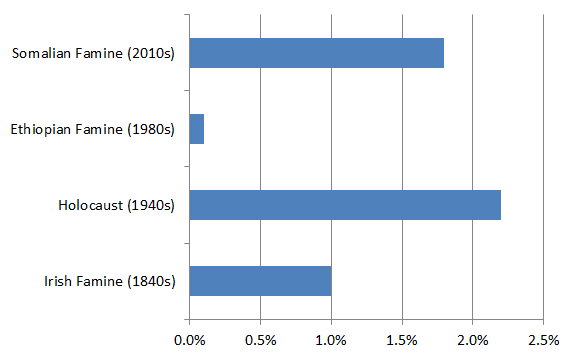2011 marks the fifth year of economic uncertainty in the developed world. The fall of stock markets in early 2007 seems a long time ago, now, and indeed almost trivial as greater crises loom for the world’s wealthiest ever people. In Europe, despite the “breakthrough” reached last week, the fate of the Eurozone hangs in the balance, as the European Union finally faces the consequences of rushing its monetary union. Meanwhile, the U.S. teeters ever closer to the brink as it dithers about its debt ceiling.
The single thread running through these worries is public debt: governments spending too much relative to their income. In Ireland and Greece, in the U.S., and in the UK, governments are borrowing a pretty astonishing 10% of the entire country’s income every year to spend. These problems are real. They are serious. And they are hogging the headlines, as analysts and politicians pore over them and obsessed about them.
But ultimately, the problem in the North is one of spending too much. Elsewhere in the world, though, there are much more serious problems – problems of too little, not too much. In particular, last week the UN officially declared famine in southern Somalia, following the worst drought in decades. Like Haiti in the Americas and North Korea in Asia, Somalia is one of the world’s basket cases. It has had no functioning national government since 1991. For reasons I don’t comprehend, no-one recognises a perfectly functioning breakaway state, Somaliland (the successor to the British protectorate in the coastal north-west part of the country).
I’ll admit something that I suspect is probably true for many of us. When the news from Somalia first emerged, my reaction was one of “yet another African crisis”. It’s a short step from there to thinking “What’s the point? Things in Africa will never change.” But this is not a story of business-as-usual from the world’s poorest continent. This is a humanitarian crisis of almost unprecedented severity, a story of a failed state being run into the ground by Al Shabab, making the lack of recognition of Somaliland even more perplexing.
The UN’s designation of famine comes after estimates that, every day, up to one in 1,700 children is dying every day in two southern regions in Somalia (southern Bakool and Lower Shabelle). To put this in perspective, if this continued for a year, 20% of the population would be dead. The graph below tries to put this unfolding catastrophe in historical perspective, by comparing current death rates in southern Somalia with those in Ethiopia a generation ago, those of Europe’s Jews in the Second World War and those of Ireland’s population in Western Europe’s last great famine in the 1840s. (It should be barely necessary for me to point out that I’m not trying to equate any of these events, merely trying to make the scale of human tragedy comprehensible.)

The current rate of deaths in southern Somalia is of the same order of magnitude as Ireland’s Great Famine and indeed of the death rate of European Jews in the Holocaust. But there is nothing inevitable about these deaths in Somalia, and there is nothing “un-liveable” about countries such as Somalia. Drought doesn’t kill – it’s just the absence of rain. Drought in California in the mid-1980s didn’t kill, at the same time as drought in Ethiopia killed hundreds of thousands. So this drought doesn’t need to kill tens of thousands of children over coming weeks and months. While the ultimate solution is sorting out the political system in Somalia, the first step is getting humanitarian aid to the people who need it.
As bad as our economic woes seem, there are nothing compared to what is happening in Somalia. To put it in context, I’m going to see Roger Daltrey in concert tonight. Between the cost of the ticket, getting there and back and having a couple of drinks at it, I’m sure to spend in excess of €100. The same amount would feed a family of six in Somalia for a month. Please bear this in mind and, if you can, make a donation through your organisation of choice. Links to three appeals are below:
Donal O'Brolchain ,
Excellent perspective and idea.
As a result of this posting, I too will contribute the total cost of tomorrow’s night out (a pre-concert meal etc) as you suggest.
Cian ,
Great post as always Ronan, and one that really puts things into perspective. $100 coming Somalia’s way from down under.
Currently Unemployed ,
A sad reminder that there are always others far worse off.
With a few changes, like stop spending so much money with the arms business or taking back natural resources from private ownership, we could make a massive difference to our fellow humans in places like Somalia. How much profit did BP make in the last quarter? 3.2 billion? And some people are complaining about it! Streuth.
How far would 3.2 billion go in Somalia if the price of a night out would feed a family for a month?
Tony S ,
Judging from the population projections in most of the global south, we havent seen nothing yet.
Heres some food for thought also.
http://www.leeds.ac.uk/demographic_entrapment/Ethiopia,%20population%20and%20food%20imports.PNG
By the way the government has made the moral hazardous step already of state-ising the process of giving to charity. So you need not feel bad about spending your own money. Additionally we are currently borrowing money from the IMF to fund our 650m euro a year overseas aid budget…. madness.
This budget needs to cut by 3/4 for the next 4 years.